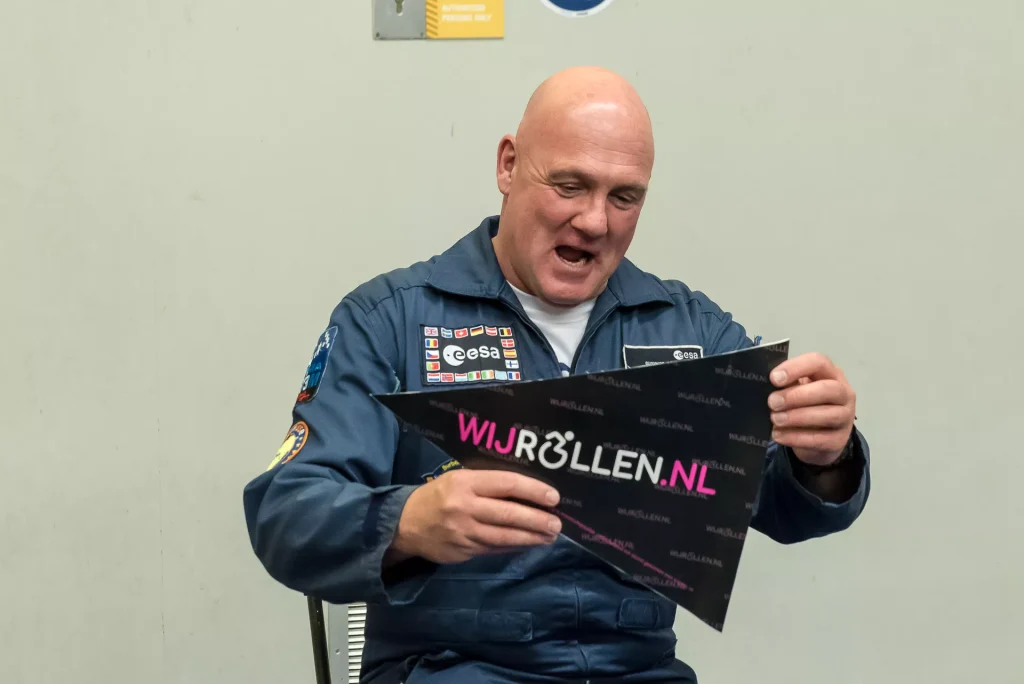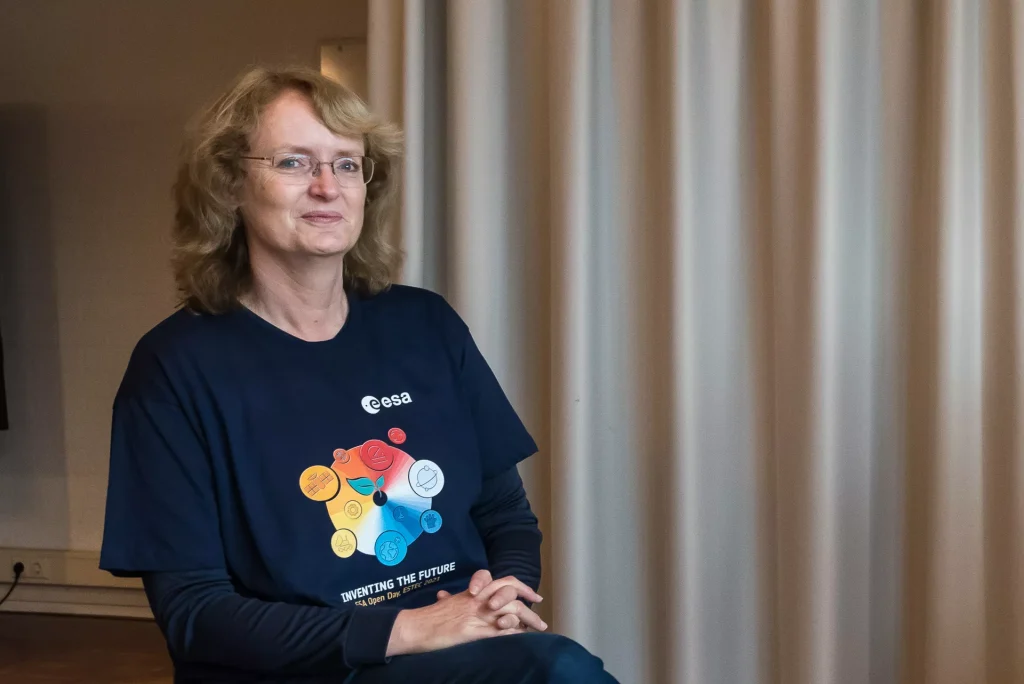
It may seem like a distant future: a wheelchair user joining space missions as an astronaut. Yet it is less crazy than you might think. The European space agency ESA is working on the para-astronaut project, which aims to see if it is possible to send the first astronaut with a disability into space. During ESA’s open day, a delegation of the WijRollen editorial team sat down with Lucy van der Tas, Head of Talent Acquisition and our own patriotic astronaut André Kuipers.
ESA, European Space Agency, has been raising its profile on diversity and inclusion in recent years. Since 2019, people with disabilities have also become more prominent. The annual ESA Open Day on 2 October was made exclusively open to people with disabilities and companions. A great opportunity for the WijRollen editors to take a look at the space industry and speak to the experts about an inclusive workplace within the space industry.
The accessible ESA Open Day
The day was opened by ESA’s Franco Ongaro, director of Technology, Engineering and Quality, together with André Kuipers and Rick Brink. In doing so, it became clear that both in the workplace and during public events, ESA is looking to become increasingly accessible and inclusive. Several hundred people with disabilities and attendants were present and were able to enter various rooms after the opening. There, dozens of ESA employees and researchers were ready to engage with the public at various information stands and presentations. For many, it was a unique and very educational day. It was also very instructive for ESA, as they would like to hear from the public what can still be improved, so that the annual open day will always be easily accessible from now on.
The day ended with a presentation by André Kuipers about his experiences as a space traveller. The audience listened breathlessly and then engaged in conversation with the astronaut. He calmly took time to answer questions and smilingly took photos with everyone. It was noticeable from everything that people enjoyed this educational and fun day.
André Kuipers in a wheelchair and as a rehabber?
At the end of the day, André Kuipers even took the time to interact with the small delegation of WijRollen editors. The first question asked: has he ever driven a wheelchair himself? “No and that seems to me to be quite a tough job. The advantage of the space is that you float. You don’t actually have a floor to walk on. The floor is then also full of stuff, because you float over it. You don’t have that when you go through my hometown of Amsterdam in a wheelchair, because then everything is in the way. I think it’s very inconvenient.”
Yet André too has had the experience of rehabilitation after coming back to earth. “Despite having to exercise two hours a day, your body is very different when you come back. You have lost your coordination, your balance organ is confused. As soon as you turn your head everything starts spinning. When you lift your arm it’s like a big magnet is pulling your arm down, because you’re not used to that weight anymore, You stumble, because you don’t feel what your legs are doing anymore. You let things fall out of your hands, because you think everything keeps floating. I had to be careful with stairs, because you think you can float down. After that, I had muscle pain for three months. Despite exercising daily, I had pain in muscles everywhere and muscles that I started using again after all this time. You also have bone loss, especially in the supporting bone. It is unclear whether that will pass. Two astronauts broke their hip once on Earth.

André Kuipers accepts roller flag
On behalf of the WijRollen editors and partner Ictoria, Nadia van den Heuvel handed over a WijRollen flag to André Kuipers. It is of course meant for the very first rolling astronaut who will ever land on the moon or any other planet. So that this big step for the rolling community can be marked. How does André feel about a possible rolling colleague?
“Fellow astronaut Samantha Cristoforetti said: we are all limited in space. Because you can’t walk or sit in space. You don’t use your legs at all. Rolling you won’t do in space, of course, because you’re floating, but a colleague who’s normally in a wheelchair, that’s actually totally fine, because everyone moves by pushing off with their hands, so I don’t see any difference.”
"Diversity is in ESA's DNA."
Beyond the search for suitable astronauts with disabilities, ESA also wants to make strides for the entire workplace when it comes to diversity and inclusion. Lucy van der Tas, Head of Talent Acquisition, explains. “Diversity is really in ESA’s DNA. From the beginning, because we work for all member states. That’s what I personally love about my job, I see European cooperation at its best every day.” The ambitions for more diversity certainly don’t stop there. Targets have been set for 2025, for example, by then 40 percent of the workplace should be made up of women.
“There is a societal reason to strive for an inclusive workplace. As ESA, we want to be able to represent everyone. We basically want to give everyone a chance to be able to go into space, regardless of where you’re from, what your gender is, and so on. Equally important is the scientific rationale for diversity. Every body reacts differently in space, also depending on your gender, age, ethnicity and therefore physical disability. Astronauts are guinea pigs, research is done on them and that is also very important.”

Opportunities for people with disabilities
“So for research, it is interesting to send people with physical disabilities into space. We started small with the call for a para-astronaut feasibility project. Now there are only a few disabilities that qualify. But we want to take a step, The Director of Human and Robotic Exploration has said, ‘if we don’t start now then we’ll never start.'” The purpose of the project is not just to send someone into space, but also to train them to become a full-fledged astronaut and also conduct research on their bodies.
When it comes to a position other than astronaut, all job openings are open to people with disabilities. “We look at the human being. I also hear from colleagues, I feel valued as a human being here. We do not keep numbers of employees with disabilities because we respect that people want to be treated as human beings. Moreover, we feel it is an invasion of privacy.”
Yet ESA also realizes that having more people with disabilities in the workplace is important. However, finding suitable candidates is not easy. “That’s because the vast majority of our vacancies require a university master’s degree in engineering or natural sciences. In addition, most jobs with us require a minimum of five years of experience in a related sector, and people don’t often become interesting until they have 10 years of experience. So far, collaborations with organizations specialized in mediating people with disabilities have not produced the right candidates. Maybe we haven’t found the right channels yet.”




